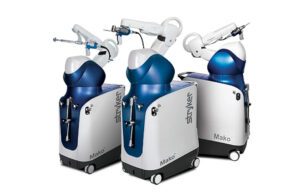
Robert Cohen is president of Stryker’s Digital Robotics and Enabling Technologies organization. [Photo courtesy of Stryker]
Stryker is tapping health data and artificial intelligence (AI) to improve surgical robotics outcomes.
Robert Cohen, president of Digital Robotics and Enabling Technologies at Stryker, recently discussed his mission with DeviceTalks Editorial Director Tom Salemi.
Stryker created the Digital Robotics and Enabling Technologies group in 2021 to “stay laser-focused on the technology,” Cohen said.
“What’s going on in the world of digital, what’s going on in the world of health records, what’s going on in the world of product security? How do we assure there’s no bias in algorithm development? We’re looking at local regulations as well as managing the R&D groups that are doing the robotics, the software, the navigation units for cranial ENT,” he said.
Previously: Stryker leaders talk medtech trends at DeviceTalks Boston
Stryker is working on ways that data collection and analysis can help surgeons personalize procedures for individual patients to improve outcomes. Stryker can pull health information from government sources, partners and unique data sets off its own equipment. The company wants to then find ways to use that data to better inform orthopedic device design and implantation, delivering software upgrades on its digital systems and portals for surgeons. Using electronic health record data in that way can benefit the entire orthopedics company, not just separate divisions.
“If you got a total hip, if you got a total knee, if you got lower spine, if you got foot and ankle, even if you got shoulder, one of the success criteria is mobility. Another success criteria is readmission, reoperation. Those are all the same, which bridges three different or four different divisions,” Cohen said. “What we try to do is consolidate that so Stryker can innovate and Stryker can accelerate and we want to do this fast and we want to be a leader.”
Supercharging the Mako surgical robotics system

The goal of Stryker’s Mako surgical robotics system is to provide more predictable outcomes. [Image courtesy of Stryker]
Cohen sees big potential for its Mako system in the next five years. The surgical robotics platform was focused on knee procedures when Stryker acquired Mako Surgical in 2013.
“We’re working on a total shoulder program. There are no robots in total shoulders right now. When that gets released, that runway is so large. There are so many different things we could do in shoulders with the existing Mako platform. So that’s a new application to an existing platform that’s super exciting. That will solve clinical issues. Then Mako spine, there’s a lot of different spine robots out there, but there’s nothing like Mako right now,” he said.
Combining the Mako surgical robotics system with Stryker’s imaging and power instrument systems will let Stryker “stand alone” in space. Cohen said. He also expects continued implant improvements through 3D printing and other technologies. All of these changes open up possibilities in joint replacements, such as smaller incisions, better placement options, shorter surgeries with less pain and faster recoveries.
Caution with AI
Cohen worries about the dangers of trendy AI products like ChatGPT, which are sometimes offering biased and inaccurate information.
Stryker’s data collection and analysis could give surgeons a uniquely useful source of information to consider while improving outcomes, safety, quality of care and efficiency.
Related: How Stryker includes users for product design in the digital age
“If we could look at things like the comorbidities of someone, the characteristics of a patient and further identify them as a unique individual, then we can pool that and have the surgeon compare that to others of like on a large database and get some insights,” he said. “Or in the operating room — This knee is too loose this way and this way. Before we do any cuts, what’s the planning? Maybe we can have some automated algorithms that’ll give the surgeon all the mathematical formulas in the background and spit out an optimal plan based on the input provided by the surgeon. That’s as far as we’re going for a period of time.”
Move fast or die
Stryker’s move-fast strategy includes partnerships with large tech companies, digital companies and entities such as hospital systems and universities that have access to data and talent.
Stryker’s buying technology to hit the market faster than it could by coming up with it internally. In the operating room, for example, Stryker in 2021 acquired Gauss Surgical, which developed technology to monitor blood loss in real time using computer vision and AI. The Gauss group is now part of Cohen’s group to leverage across the entire organization.
“It shows you at Stryker, we’re going to get this stuff and put it on steroids, and we’re going to go quick. … It doesn’t matter how big Stryker is. It doesn’t matter how long Stryker has been around. A slow company will fail.”
Listen to the whole conversation with Cohen at DeviceTalks.com or below.